"A word as to Colors and Color bearers etc.
At the organization of the regiment Co. E was Color company and Sgt. P. Mayo Spears color bearer. Shiloh was the only engagement in which the regiment had taken a hand before the reorganization. After the reorganization in May 1862 Co. G was the Color Company and Sgt. Festus O'Conner of Hopkins County was color bearer in every engagement to the close of the war. But in August 1864 when the C. S. Congress passed a law making the Color bearer a Commissioned officer with rank and pay of 2nd Lieut. Col. Young appointed Ben R. Milam a worthy young man color bearer but before he had an opportunity to carry the colors in action a stray ball from Yankee Sharp shooters struck him in the hand while holding up the flag. And placed him "hors du Combat" for the rest of the war. A few later Charles Douglass was appointed. He had scarcely raised the Colors till a minnie ball struck him about the center and upper part of the Sternum from which he soon died -- the Colors were thus returned to Connor who bore them aloft in every engagement to the day he stacked the old flag, (which was exhibited at Sherman) with the Surrendered Stacked arms at Meridian Miss. on the 12th of May 1865. The Stand of colors with which the regiment marched from Texas were not used after the reorganization and my recollection is that about three stands of colors had been shot all to pieces before the one surrendered.
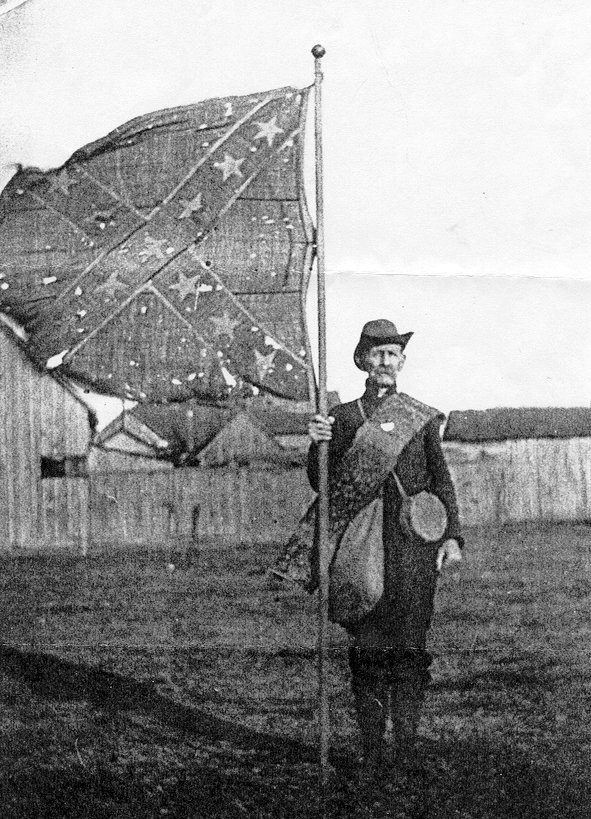 Conner had carried the flag in every action and had carried it high and well to the front and I think three stands had been shot all to tatters, and the Surrendered flag instead of fifty, had one hundred and fifty minnie bullet holes besides in the upper and outer corner. Something a little more scary if not more dangerous had bestowed a kiss upon it which clearly left its imprint upon it. . . . that old flag is simply of 9th Texas infantry, and carried by Col. W. H. Long and for more than three years of the war in Ector's Brigade. Nor was that flag surrendered at Spanish Fort, but at Meridian Miss. It had not fifty, but 159 bullet holes in it and it was not brought home by Capt. W. H. H. Long, who came home in August before surrender in May, but by Mr. C. P. Matthews of your county by whom it was detached from the staff and the staff was also brought home by Mr. C. P. Matthews and Lt. Jenkins of McKinney."
Conner had carried the flag in every action and had carried it high and well to the front and I think three stands had been shot all to tatters, and the Surrendered flag instead of fifty, had one hundred and fifty minnie bullet holes besides in the upper and outer corner. Something a little more scary if not more dangerous had bestowed a kiss upon it which clearly left its imprint upon it. . . . that old flag is simply of 9th Texas infantry, and carried by Col. W. H. Long and for more than three years of the war in Ector's Brigade. Nor was that flag surrendered at Spanish Fort, but at Meridian Miss. It had not fifty, but 159 bullet holes in it and it was not brought home by Capt. W. H. H. Long, who came home in August before surrender in May, but by Mr. C. P. Matthews of your county by whom it was detached from the staff and the staff was also brought home by Mr. C. P. Matthews and Lt. Jenkins of McKinney."
John E. Lozedon, formerly 2nd Cpl. of Co. C, wrote this account to the Confederate Veteran, Volume 17, page 455:
FLAG OF NINTH TEXAS INFANTRY
By John E. Lozedon, Gainesville, Texas
"The April VETERAN gave a list of Confederate flags captured during the Civil War and held at the capitol in Ohio. One of these is said to have been captured from the 9th Texas. It may have been captured from the 9th Texas Cavalry Regiment, but I am sure it was not captured from the 9th Texas Infantry, as our regiment did not lose a flag during the war.
The 9th Texas Infantry was not in the battle of Corinth, but was in Bragg's army, then in retreat out of Kentucky after the battle at Perryville. All of the members of the 9th Texas Infantry who stayed with it until the close of the war are proud of the record the regiment made, and we do not want the readers of the VETERAN to think that we lost our flag when we know that such was not the case.
I was with the regiment in every battle during the four years of the war. I was wounded in the battle of Murfreesboro, in December, 1862, and wounded again in the battle of Nashville, in December, 1864. Both were flesh wounds, and I was able to report for duty in time to be with my comrades in the next fight. I was in the Fairground Hospital at Atlanta six weeks nursing the wound received at Murfreesboro.
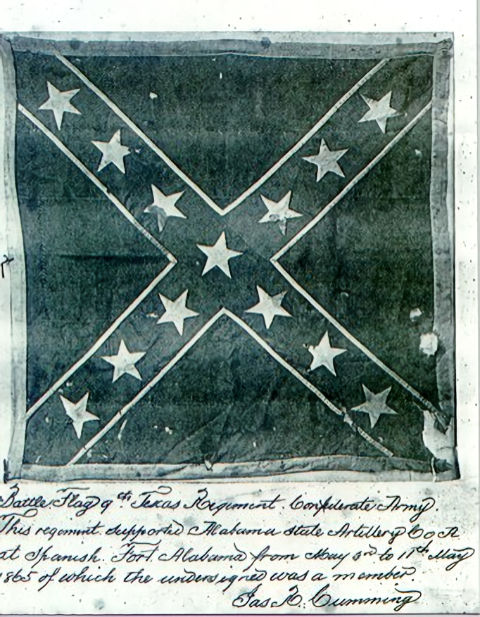 At the final surrender when Ector's Texas Brigade stacked arms the color bearer stacked the flag with the guns. A comrade, C. P. Matthews, of Paris, Tex., went to the old flag, cut it from the staff, crammed it into his shirt bosom, and brought it home with him. Charlie has the old flag yet."
At the final surrender when Ector's Texas Brigade stacked arms the color bearer stacked the flag with the guns. A comrade, C. P. Matthews, of Paris, Tex., went to the old flag, cut it from the staff, crammed it into his shirt bosom, and brought it home with him. Charlie has the old flag yet."
This is a photograph of the actual battle flag probably before the turn of the century. The caption is handwritten and states: "Battle Flag 9th Texas Regiment, Confederate Army. This regiment supported Alabama State Artillery Co. A at Spanish Fort, Alabama from May 3rd to 11th May 1865 of which the undersigned was a member. Jas. H. Cumming. (Pvt., Co. H)
SEARCHING FOR ANY REMAINS
In 1998 my friend and associate Tim Bell gave me a photocopy of a picture that had been given to him at a re-enactment. It was reported to be of Charles Price Matthews, standing in front of a house holding the flag of the regiment during a Confederate reunion held in Lee Park in Dallas (date unknown). For the last two years I have looked for descendants of Matthews to no avail to verify his.
Rumors abound that the original flag was in the hands of a collector who did not want to be identified and who lived somewhere in Arkansas.
Then one day a local librarian in Paris showed me a book he had purchased at a garage sale about the battle flags of the Army of Tennessee by H. M. Madaus. I searched for the author and found him at the Buffalo Bill Historical Center in Cody, Wyoming. There was no reference to a battle flag for the 9th Texas Infantry in his book, but on a hunch, I thought it would not hurt to contact him anyway. (That book is now out of print but he is working on a sequel for which a publish date has not yet been determined.)
Mr. Madaus wrote back to me to acknowledge that he had actually seen, measured and made a scale drawing of the flag of the 9th Texas Infantry and sent me the following dimensions.
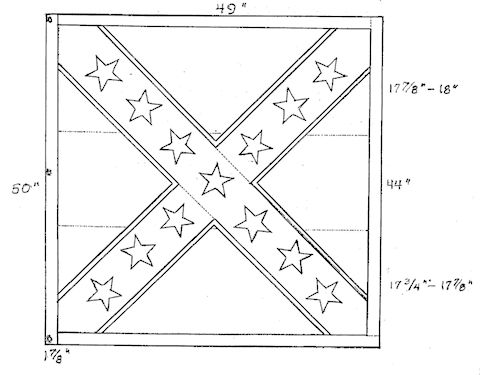 The flag, 50 in. along the staff and 49 in. along the fly
The flag, 50 in. along the staff and 49 in. along the fly
Field, red of bunting
Cross, dark blue, 7 - 7 1/4 in. of bunting
Edge, white, in. wide of cotton
Stars, (13) white, 5 ptd., each 5 - 5 3/4 in. in diameter of cotton
Border, white, 2 in. wide of bunting
Method of attachment: three whipped eyelets pierce the white canvas heading 1 7/8 in. wide
Star separation: center-1st 8 - 8 in.; center-2nd: 16 1/4 - 17 in.; center-3rd: 24 in.
Mr. Madaus wrote to me stating, "The flag is of the pattern made at the Richmond Clothing Depot between the end of May 1864 and September 1864. Three other flags of this same pattern were captured at Spanish Fort, (Alabama) on 9 Apr 1865, presumably from the other units of Ector's Brigade. Why Ector's Brigade was favored with an issue of battle flags from the Richmond Depot (when its normal supply source would have been Mobile) is an enigma that still needs to be solved. I would suspect that Ector and his associates had friends in Richmond who arranged for the issue, but I have no confirming documentation."
Receiving flags from Richmond would indeed have been unusual. Gary Wisler, author and student of the 9th, concludes that according to the diary of Charles B. Douglass in the Tennessee State Library, Colonel William H. Young of the regiment, who would for a short time command the brigade, went to Richmond on March 31, 1864. Although Douglass doesn't state the reason in his diary, he hints that Young was hoping to remount the Texas regiments (and to mount the men of the 9th Infantry, who had never served as mounted troops). Young returned on May 10, 1864, and Douglass mentions that on May 12, Col. Young presented a new flag to each regiment. This account should explain why the flags came from Richmond and that they were subsequently presented to the various other regiments. Young was a student at the University of Virginia before the war and married into a prominent Virginia family. Although remarkably young to command a regiment and later the brigade, he enjoyed the support of his superiors and the admiration of his men.
I was able to get in touch with a Mr. Bartlett of San Antonio who had purchased the flag from a man in Arkansas. He wrote back to inform me that he no longer owned the flag and had sold it to a Mr. Ray Richey of Ft. Worth, Texas. He then forwarded my letter and request to Mr. Richey informing him of my interest in the flag.
Mr. Richey graciously wrote to me in February 1999 and stated that the flag was now in a restoration process in Sharpsburg, Maryland and that he would get me a picture of it when it was finished "later" in 1999. Coincidently, he shares the surname of Barney Richey of the 9th but any ancestry to that soldier is unknown to him at this time.
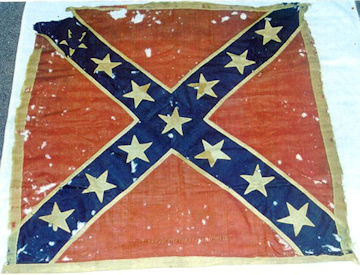
Over the years Mr. Richey has collected other regimental flags but this is his first Texas regiment flag to come into his collection. At this time there is no plans for any public display. We wish to thank him for rescuing the flag of the Ninth from obscurity and possible extinction and wish him the best in his future enterprises.
Martin L. Callahan, author, collector and historian, of San Antonio sent me this color photograph taken of the flag a few years ago while it was in the possession of Mr. Bartlett.
(The three pictures of Matthews parading the flag are from two different sources who have declined to answer my inquiries for permission to post them. One of them is even suppose to be a Confederate retail outlet in Austin Texas.)
Charles Price Matthews was born 27 Nov 1837 and died 25 Feb 1924. He is buried in Evergreen Cemetery, block K-17SW-04, in Paris, Lamar County, Texas. He saved our flag from oblivion.
THE PARIS MORNING NEWS
Tuesday, February 26, 1924
"Chas. P. Matthews, an old and well known resident of Paris, died at 5 o'clock Monday morning at his home at 82 South Twenty-fifth street. His death was due principally to infirmity incident to old age. He had been confined to bed since the 3rd of last October. He was in his 87th year, having been born in Bedford City, Va., November 27, 1837 [sic]. He came to Texas in 1856 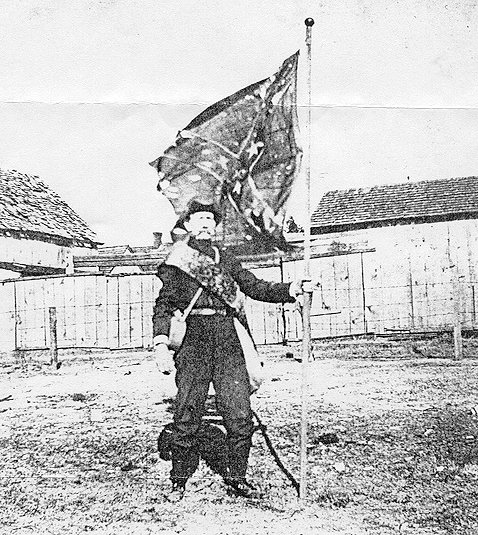 while he was still a youth and located in Paris. For a while he clerked in the store of John Broad, a pioneer merchant, on the north side of the square. He was for several years engaged in the cotton business and was well known among the cotton buyers of this section. When the Civil war began he Joined the Confederate army enlisting in General S. B. Maxey's Ninth Texas Regiment at Paris. After the war he returned to his home in Paris, where he continued to reside up to the time of his death. He served four years as county tax assessor and was a member of Albert Sidney Johnston camp Confederate veterans. In 1868 [sic] he married Miss Laura Long, daughter of Edward and Polly Long, pioneer residents of Paris, who came here with the Williams family from Kentucky. He is survived by a son and a daughter, Edward L. Matthews of Fort Smith, Ark., who is a conductor on the Frisco railroad, and Miss Minnie Matthews of Paris. He is also survived by a sister in Missouri and other relatives. The funeral service will be held at 10:30 o'clock this morning at the residence, Rev. F. L. Wear officiating. The burial will be at Evergreen cemetery."
while he was still a youth and located in Paris. For a while he clerked in the store of John Broad, a pioneer merchant, on the north side of the square. He was for several years engaged in the cotton business and was well known among the cotton buyers of this section. When the Civil war began he Joined the Confederate army enlisting in General S. B. Maxey's Ninth Texas Regiment at Paris. After the war he returned to his home in Paris, where he continued to reside up to the time of his death. He served four years as county tax assessor and was a member of Albert Sidney Johnston camp Confederate veterans. In 1868 [sic] he married Miss Laura Long, daughter of Edward and Polly Long, pioneer residents of Paris, who came here with the Williams family from Kentucky. He is survived by a son and a daughter, Edward L. Matthews of Fort Smith, Ark., who is a conductor on the Frisco railroad, and Miss Minnie Matthews of Paris. He is also survived by a sister in Missouri and other relatives. The funeral service will be held at 10:30 o'clock this morning at the residence, Rev. F. L. Wear officiating. The burial will be at Evergreen cemetery."
Charles Price Matthews received a pension #30336 from the State of Texas for his service in the Confederate Army.
Lamar Co. Marriage Record Book 4, p. 16, C. P. Matthews married Laura E. Long on 19 Dec 1866. Service Record as abstracted by Tim Bell states:
C. P. Matthews, age 23, enlisted as a Private in Co. C, 9th Texas Infantry on 4 Oct 1861 in Sherman, Grayson Co. TX under W. H. Young. March, 1862-sick at Iuka; April, 1862-AWOL; detached as Ward Master, Columbus, MS, hospital, 5/22/62-shown as same on all rolls to May/June, 1863; present, July-October, 1863, 4/5/64. POW, Meridian, MS, 5/4/65, as a member of Company I, 9th Texas, commanded by Capt. R. M. Board-paroled, Meridian, 5/11/65. Residence: Lamar County, Texas.